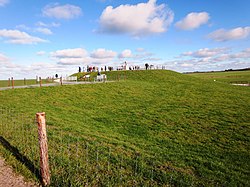III. Oldenburg dike tape
| III. Oldenburg dike tape | |
|---|---|
| legal form | Public corporation |
| founding | 1855
|
| place | Jever |
| Board | Hurry-Onno Garlichs |
| Website | www.wabo-jever.de |
The III. Oldenburgische Deichband is a dyke association founded in 1855 with headquarters in Jever . It is administered by the joint office of the water and soil associations in the district of Friesland .
Association area
The Deichverband is responsible for an area of around 50,000 hectares in the district of Friesland and the independent city of Wilhelmshaven . This protected area, which includes all plots of land located under the protection of the main dykes up to a height of +5.00 m above sea level including the higher ground elevations within this area, extends over the independent city of Wilhelmshaven, the communities of Sande , Schortens , Wangerland and the City of Jever and parts of the communities Bockhorn , Zetel , Friedeburg and the city of Varel .
The main dyke line in the area of responsibility of III. Oldenburgische Deichbandes is 59.8 kilometers long. It extends from the general plan kilometer 227.3 on the border between the district of Friesland and the district of Wittmund near Harlesiel to the general plan kilometer 287.1 on the east side of the Dangast low near Dangast . The main dyke line is divided into five dykes. The 1st dyke pull includes the dike association kilometers 0.0 at Harlesiel to 17.45 near Horumersiel , the second dike association the dyke association kilometers 17.45 to 26.7 at the Hooksieler Binnentief , the third dyke association the dyke association kilometers 26.7 to 38.8 at Heppenser Groden in Wilhelmshaven, the 4th dike association kilometer 38.8 to 45.9 at Banter See in Wilhelmshaven and the 5th dike association kilometer 45.9 to 59.7 at Dangast.
In the responsibility of the III. Oldenburgische Deichbandes has also been a 3.7 kilometer long section of the main dike in Wilhelmshaven since January 1, 2006, which runs between the Banter Siel and the naval base and was previously managed by the Lower Saxony State Office for Water Management, Coastal Protection and Nature Conservation .
In addition to the main dyke line, there is a 40-kilometer-long second dyke line on Elisabethgroden, between Horumersiel and Hooksiel and in the area of the Voslapper , Rüstersieler and Heppenser Groden.
The association area of the III. Oldenburgische Deichbandes borders in the west on the association area of the Esens-Harlingerland dyke and in the south on the association area of the II. Oldenburgische Deichbandes .

Association structure
The association is represented by a committee that is elected by the association members. The committee consists of 17 members and in turn elects a board of five members. For the monitoring of the individual dyke sections and the work to be carried out on them, the association appoints dyke jury appointed by the board.
Members of the association are all landowners and leaseholders of the properties located in the association area.
tasks
The dyke association has the task of protecting properties in the association area from storm surges and floods . To this end, he maintains the dikes in the association area.
Most of the dike sections are grazed with sheep. The sheep hold the grass briefly and trample the ground. In this way, they ensure a short, closed and firm sward, which is important for dike safety. The III. For this purpose, the Oldenburgische Deichband maintains dike sheep farms on Elisabethgroden and Voslapper Groden.
literature
- O. Tenge: The Jeversche Deichband: History and description of the dikes, embankments and sluices in the third Oldenburg Deichbande and in the Royal Prussian western Jade area. 1898, accessed February 9, 2014 .
- Heiner Blischke: Coastal protection in the III. Oldenburgische Deichband "Leben on the Coast" issue 1 . Oskar Berg, Bockhorn 2001, ISBN 3-9806956-1-1 .
- Ulrike Oltmanns & Hans-Jörg Frick: Coastal protection in the III. Oldenburgische Deichband "From the Wurt to modern dyke construction" Volume 2 . KomRegis-Verlag, Oldenburg 2005, ISBN 3-938501-06-5 .
Web links
Individual evidence
- ^ Website of the III. Oldenburg dike band . Retrieved July 12, 2012.
- ↑ a b c d III. Oldenburger Deichband , water and soil associations in the Friesland district. Retrieved July 12, 2012.
- ↑ a b Overview of the dike associations in Lower Saxony and Bremen (PDF; 9.5 MB) , map Annex 8. Accessed on July 12, 2012.
- ↑ The last state dike in Wilhelmshaven goes to the Deichverband , Lower Saxony State Agency for Water Management, Coastal and Nature Conservation, January 19, 2007. Accessed on July 12, 2012.
- ↑ Melanie Hanz: Deichschafe auf den Rückzug , Nordwest-Zeitung , February 27, 2010. Retrieved on February 11, 2016.